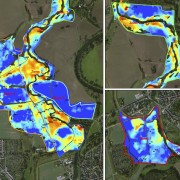Detailopnames van dioxine verontreiniging in Duitse bodem
Mapping sediment bound organic pollutants (pdf)
For many decades waste water from the chemical industry located at the Bitterfeld-Wolfen industrial mega-site was discharged into the Spittelwasser creek without treatment. Several organic chemicals released from the site through the Spittelwasser, namely polychlorinated dibenzodioxins and furans (PCDD/F), hexachlorocyclohexane (HCH), and organotin compounds, are among the most relevant parameters impairing the surface water quality of the river Elbe.
In the scope of the realignment of the Elbe river basin management, based on the EU Water Framework Directive (WFD) and the respective national legislation including the river basin management plans, requirements for actions to improve the surface water quality have been specified with particular regard to the management objectives. Reduction targets were defined related to the historical industry at the Bitterfeld-Wolfen site and the Bitterfeld area became one of the primary subjects of the considerations for future corrective. However, knowledge of the system and the related processes was, at that time, neither sufficient to identify appropriate locations nor to determine the extent of possible corrective
actions. Tauw was contracted by the Landesanstalt für Altlastenfreistellung(LAF)in2010todesignandconductastudy. The goal of the study was to obtain a detailed understanding of the current state of the system and by that provide the competent authorities with a robust basis for future decisions on corrective actions.
A large investigation program was performed for a period of one year. Water and suspended sediments were sampled at every river section and analyzed for the relevant organic parameters. In addition, the quantity and quality of sediment in the Spittelwasser creek and the Mulde river were investigated and the contaminants in the Spittelwasser floodplain were mapped in collaboration with MEDUSA bv. The results revealed a completely new picture of the status and the development of the surface water contamination in the Spittelwasser and its role in the Elbe river basin. Corrective action, as the dredging of sediments in the Spittelwasser creek, which had been vehemently demanded in the political discussion were shown to be ineffectual while other areas were identified as potential targets for future actions.



